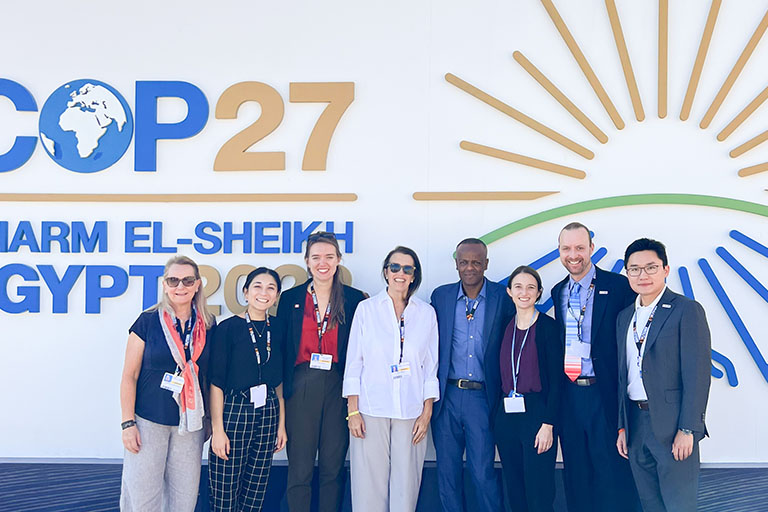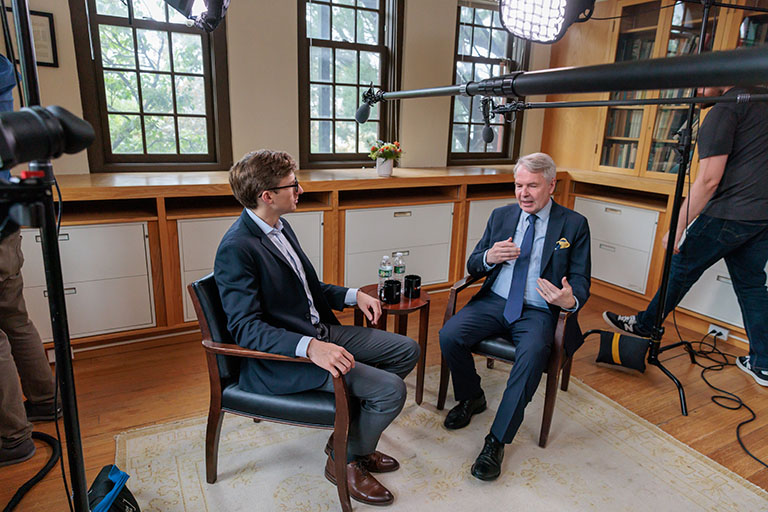-

Hear from Professor Monica Toft
Learn how Professor Monica Toft is shaping the study of global affairs and diplomacy at Fletcher.
Hear from Prof. Toft -

Explore Fletcher academics in action
Fletcher Features offers insights, innovation, stories and expertise by scholars.
Get global insights -
Get application tips right from the source
Learn tips, tricks, and behind-the-scenes insights on applying to Fletcher from our admissions counselors.
Hear from Admissions -

Research that the world is talking about
Stay up to date on the latest research, innovation, and thought leadership from our newsroom.
Stay informed -
Meet Fletcherites and their stories
Get to know our vibrant community through news stories highlighting faculty, students, and alumni.
Meet Fletcherites -

Forge your future after Fletcher
Watch to see how Fletcher prepares global thinkers for success across industries.
See the impact -

Global insights and expertise, on demand.
Need a global affairs expert for a timely and insightful take? Fletcher faculty are available for media inquiries.
Get in Touch
Offshore Wind Makes Waves
Students and faculty at Fletcher and the School of Engineering partner to study offshore wind

Professor of Practice Barbara Kates-Garnick has high hopes that the United States can meet its climate targets, thanks to a renewable resource found in The Fletcher School’s backyard: offshore wind.
“Offshore wind is really a way that we are going to meet our climate goals in the country,” said Kates-Garnick, “in large part because we have a huge source of renewable energy.”
Offshore Wind at Tufts
June 15 marks Global Wind Day, a celebration that recognizes the importance of wind energy. At Tufts, a group of Fletcher faculty and students are collaborating with the School of Engineering to understand the potential for offshore wind as a game changer in confronting the climate crisis and to recommend smarter policy.
“Traditionally, on the east coast of the U.S., we haven't really had indigenous resources," said Kates-Garnick. "It's been Texas, Louisiana. Now with offshore wind, we have an indigenous source of energy off of our coastlines. We have a huge resource available to us –– that's a really exciting thing. States from North Carolina to Maine are trying to harness the wind off their coastlines.”
Vineyard Wind, the first industrial size offshore windfarm in the U.S., is expected to open off the coast of Cape Cod in late 2023 or early 2024. The farm is projected to harness 800 megawatts of power, carried to a point of interconnection in Cape Cod, where it will then travel along lines below the streets to a substation and then enter the grid. Kates-Garnick noted that capacity of Vineyard Wind will be significant; for reference, the largest nuclear generator in New England is about 1200 MW. State and independent analyses suggest that New England will need between 30-45 gigawatts of OSW to reach its climate goals by 2050. Much of this is already in the planning stage.
Once that energy reaches the shore, though, myriad questions arise. In addition to the engineering and environmental questions that accompany installing massive wind turbines into the ocean floor and ensuring their proper functioning, offshore wind farms are managed at turns by various jurisdictions. These farms are located in federal waters, where they are subject to regulation by the Bureau of Ocean Energy Management (BOEM). BOEM determines where in the ocean these farms can be built and evaluates environmental implications. When the energy comes to shore, it enters state jurisdiction. Transmission depends upon regional organizations that operate the transmission lines; these interstate transmission lines fall under federal jurisdiction.
Intersecting Policy and Engineering
For Julie Harris F22 EG26 these questions represent the perfect intersection of her interests in policy and engineering. Harris majored in engineering and visual arts during her undergraduate education. Prior to enrolling at Fletcher for her MALD, she worked at a nuclear remediation site, where she saw firsthand how the engineering concepts she’d studied in college interacted with policy considerations. During her first semester at Fletcher, Harris was captivated by Kates-Garnick’s class on energy policy. She connected with Kates-Garnick and enrolled in a class the following semester, co-taught with Professor Eric Hines from the engineering school, in which students completed research papers on offshore wind.
“Offshore wind is changing the way that we're looking at our energy industry: what our grids should look like, what our energy portfolio in this country will look like,” said Harris.
Recommending effective policy for offshore wind requires a deep knowledge of both engineering as well as the layered policy interests from the federal to state and regional levels. Now as a PhD student, Harris continues to examine these questions.
“Offshore wind has this very close tie between the engineering problems and the policy problems," she said. "You've got these questions about our physical limitations in where we can and can't move energy, where would it be most advantageous to do upgrades to minimize cost and maximize benefit. Meanwhile, you're running into policy questions of whose jurisdiction this is, what the process looks like right now and how we can make the entire process more efficient. I’m excited to be in this place that has such a close tie between the engineering and the policy.”
Offshore Wind Impact on Marine Life
Offshore wind represents an important area of cooperation between Fletcher and the School of Engineering. Students working in this area also study the impact on marine ecosystems. Installation can be disruptive to whales during their migration, and Kates-Garnick noted concerns of noise pollution for marine life. Decommissioning wind farms also creates concerns for environmental impact. The group investigates these questions of infrastructure development through the lenses of supply chains and environmental justice.
“I think that part of the brilliance of the engineering-policy connection is that as we look at the different options from an integrated perspective, as well as our sensitivities to the environmental, engineering and policy implications of our decision making,” said Kates-Garnick. “Decisions on infrastructure made today will last for up to 100 years. Decision makers have to be knowledgeable about the choices and their timeframes and impacts.”
“These are all these intersectional issues,” she added. “We don't have the answers, but this is what we're studying and working on, and that next generation will have more answers than we have today. We're pioneering.”
To continue sharing this research with stakeholders, the group has invited leading policymakers to campus for a conference on June 22 on offshore wind policy and technology.
Read more about Offshore Wind at Tufts and the Offshore Wind Transmission Workshop.

